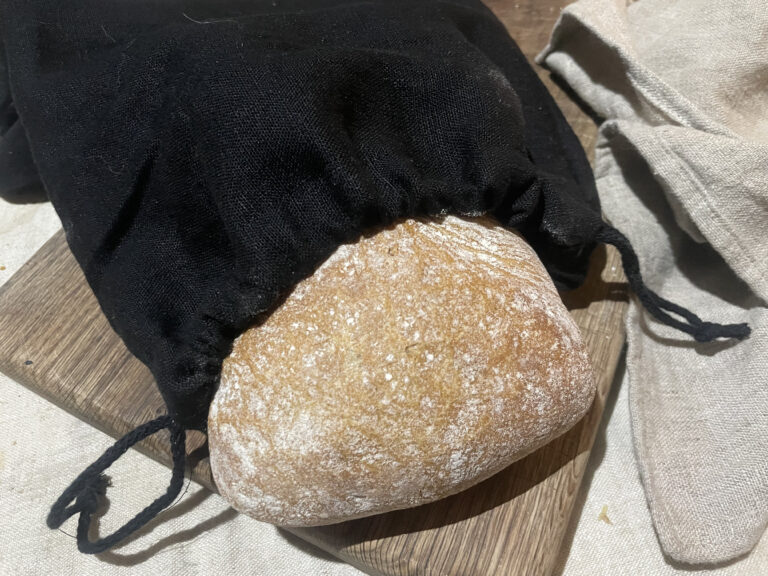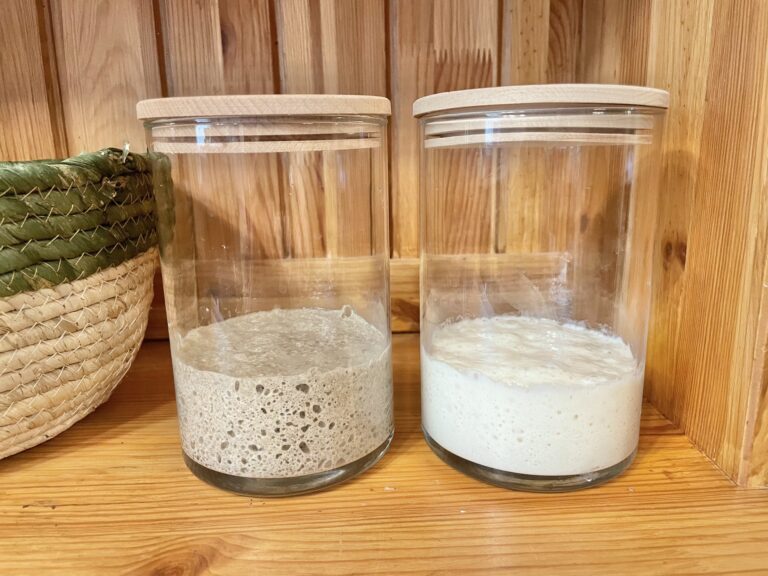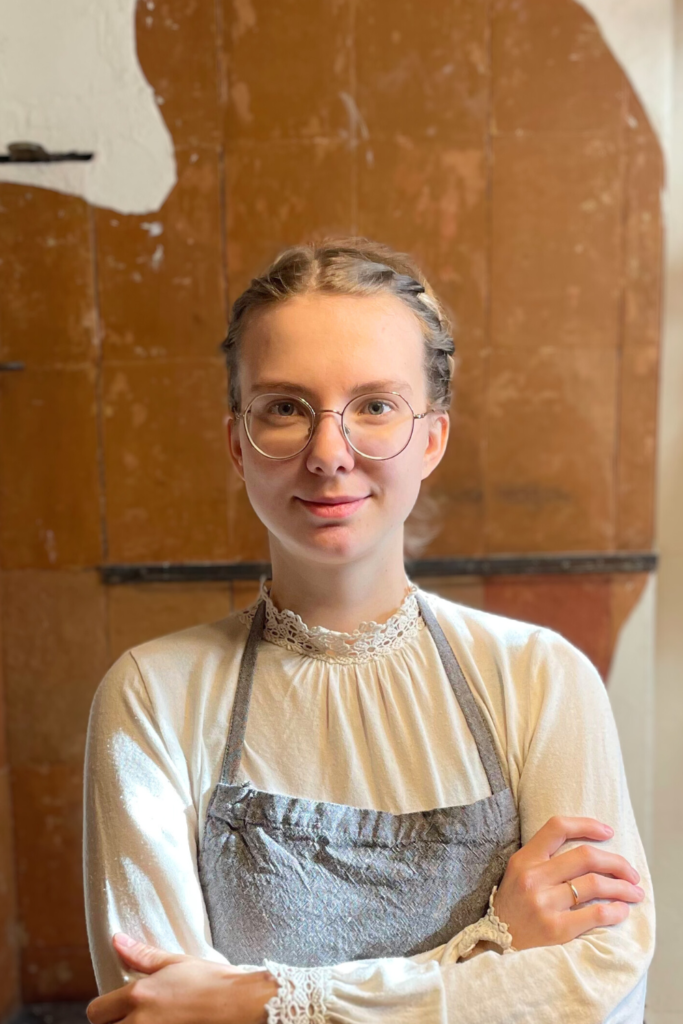An apron or even a half apron is an essential item in every household. It’s incredibly convenient for cooking and cleaning, keeping your clothes free from stains. While cooking, I also use the apron to quickly wipe my hands, avoiding the need to run to the sink to wash them constantly. However, when designing this apron, my goal was to create a functional piece and a stylish addition to home attire. Even a homemaker should look dignified. So, this apron is both practical and beautiful, and making it by yourself is so much fun.

There are different ways to sew an apron, but when I designed this apron pattern, I drew inspiration from traditional aprons dating back centuries. It’s not only beautiful, elegant, and dignified but also a practical and smart solution. I added pockets to the front of the apron, which I believe are very useful additions. Often, I check a recipe on my phone, and it’s so convenient to have it in the apron pocket, easily within reach. Placing the phone on the kitchen counter can lead to it getting dirty or becoming an obstacle. It’s also very convenient to use the apron pocket to collect vegetables or other ingredients that need to be taken to the stove or put a tea towel inside, for example.
Before you start reading, come and follow me on Instagram, Facebook, and Pinterest!
Choosing Fabric for the Apron
For making the apron, you may use different fabrics, but I believe the best fabric is linen or cotton. I can’t stress enough how much I dislike synthetic fabrics, I’m a complete fanatic for natural fiber! But the advantage of natural fabric is its excellent liquid absorbency, making it handy for drying hands as well. Linen fabric is also very durable and can maintain its structure and appearance for decades. While you can make a lovely apron with about half the amount of fabric, it’s the gathered look that makes this apron elegant, and that requires more fabric.
Necessary Items for Sewing the Apron
Fabric – Choose your preferred fabric. The material should be approximately 59 inches long and 79 inches wide.
Thread – Make sure the thread matches the fabric color. But in this case, you won’t have a leftover fabric, so measuring inaccurately is not allowed.
Sewing machine
Scissors
Measuring tape
Pins
Sewing an Apron
Making this apron involves cutting quite a few pieces, and you might not finish it all in one day. Nevertheless, despite the many details and lengthy instructions, it’s still straightforward because there are many repetitive motifs, and you’ll perform the same steps several times in various places. So, make yourself a cup of tea, and let’s get to work!
Gathering the Fabric
In this apron design, I’ve used ruffles in several places. Creating a gathered edge is quite easy. The first time I tried to make ruffles, I did it by hand because I thought it would be extremely challenging to do with a sewing machine. However, when I eventually tried it with a sewing machine, I realized how easy it is, and ever since, I have used ruffles in my sewing projects as much as possible because it’s enjoyable to do, and the result always looks beautiful.
Gathering by hand
Gathering by hand is theoretically possible, but it can be time-consuming. To do that, you’ll need a needle and thread.
- Thread the needle.
- Start gathering the fabric by folding it like an accordion with short, approximately 0.4-inch intervals between the folds. Maintain about a 0.2-inch distance from the fabric edge.
- Continue gathering the edge throughout its length without breaking the thread in between.
- After gathering, you can adjust the gathered edge to your desired width by moving it.

Gathering with a machine
It is much simpler than doing it by hand. To do that, you’ll create a standard seam line along the edge of the fabric, but you need to release the tension of the upper thread.
- Turn the upper thread tension adjustment to the lowest setting, i.e., zero. The exact location of the thread tension adjustment may vary slightly on different machines. If you don’t know how to locate the tension adjuster on your machine, it should be described in the machine’s user manual. If you don’t have the user manual, you can search online by entering the machine’s manufacturer and model to find one.
- Then, sew a straight line about 0.2 inches away from the fabric edge.
- At both ends of the seam, you now have two hanging threads: one is the lower bobbin thread, and the other is the upper thread that comes from the thread spool. The upper thread is loose, allowing the lower thread to move freely. Hold onto the lower thread and start gathering the fabric together.
- Don’t forget to return the thread tension adjustment knob to its original position after gathering. I’ve forgotten to do this on several occasions and ended up sewing with one loose thread, which required me to unpick everything and start over.

Apron Skirt
Let’s begin sewing the skirt part of the apron. Regarding measurements, you can be relatively flexible with the skirt. The width of the skirt should primarily depend on the width of the fabric. An optimal width is around 55-59 inches. If there’s too much fabric, the skirt might appear too puffy, and if there’s too little, the elegant gathered look might be lost. When making pattern pieces, try to minimize fabric waste as much as possible.
- The first step is to cut out the skirt section in a rectangular shape. You can choose the dimensions according to your preference, but optimal measurements are a length of about 26 inches plus a 1-inch seam allowance and a width of about 59 inches. Remember that an additional 5 inches of pleated edge will be added to the skirt’s length.
- Cut out two pocket pieces. The pocket’s width and length are the same: about 7 inches plus a 1.6-inch seam allowance.
- Hem all edges of the pockets. If you’re unsure how to create a hem, I’ve provided a detailed guide in this post. Only stitch the top edge of the pocket.
- Attach the pockets to the apron with pins, ensuring they are positioned about 9.8 inches from the top edge and about 10.2 inches from the outer edges.
- Stitch the pockets to the apron with a double seam to secure the hem and prevent it from unraveling. Be careful not to sew the top of the pocket shut.

- Cut out a ruffle strip. The ruffle strip should be about 5 inches in width, plus a 1.2-inch seam allowance, and approximately half the width of the bottom edge of the skirt, about 118 inches. I recommend sewing two about 59-inch fabric strips together. To join the fabric strips, place them with their wrong sides out and sew a straight stitch, leaving you with a seam on one side and fabric excess on the other.
- Gather one long side of the ruffle strip.
- Attach the gathered edge to the bottom edge of the skirt, making sure the ruffled edge remains consistent. Ensure the right sides are facing each other. Be cautious to avoid the gathered edge from coming loose.
- Stitch the ruffle you’ve pinned to secure it in place.

- Hem both sides and the bottom of the apron entirely, except leave the top edge without hemming.
- Make the gathered top edge of the apron panel and set it aside.
Apron Top Section
- Cut out the top section of the apron. The length of the top section should be approximately 13 inches (+ 0.8 inches for seam allowance). You can also measure the length of your body from the center of your chest (where the top of the apron will be) to your waist. The width of the bottom edge of the top section should be 8 inches, and the width of the top edge is 10 inches. So, the top section of the apron is trapezoidal. The easiest way to mark this is by folding the fabric in half and applying the smaller sizes to the fabric.
- Hem the upper edge of the top section and set the fabric aside.

- Cut out four fabric strips for the apron tie pieces. The width of one fabric strip is 1.6 inches (+ 0.8 inches for seam allowance), and the length is approximately 36 inches (+ 0.8 inches for seam allowance).
- Cut out 2 fabric strips for the ruffles on the ties. The length of the ruffles should be about 59 inches. The width of the ruffles can be such that they are narrower at the edges and wider in the middle. At the edges, the width should be 1.2 inches (+ 1.2 inches for seam allowance), and in the middle, the width should be 2.4 inches (+ 1.2 inches for seam allowance). The ruffle fabric should look like one edge is straight, and the other edge is curved.
- Hem the curved edge of the ruffles.
- Gather the straight edge of the ruffles. Set the ruffles aside.
- Take two of the tie pieces and place them on one side edge of the top section of the apron so that the top section of the apron is sandwiched between them. Take a close look at the picture! Place pins and sew them together.

- If desired, you can also add a decorative stitch on top.
- Now, take the ruffle strip and gather it to the same length as the ties, which is 36. inches (+ 0.8 inches for seam allowance), and place it between the two tie strips. Fold the edges of the tie strips inward, pin them, and sew them together. Do the same with the other side.

Assembling the Apron
The good news is that the hard part is over! You’ve completed the lower and upper sections of the apron. Now, you need to put them together, and for that, you’ll need waist ties.
- Cut out the waistband. The width of the waistband is 1.6 inches (+ 0.8 inches), and the length is 92 inches (+ seam allowance). Since the waistband is quite long, we will put it together from three pieces: the middle piece is 24 inches (+ 0.8 inches), and the outer pieces are 34 inches (+ 1.6 inches for seam allowance). You’ll need to make two sets of these pieces, as we will join them together.
- Sew three fabric strips for each side of the waistband together.
- Now, you need to layer all the fabric pieces in the correct order. Take your time, think logically, and if you make a mistake, you can always unpick and start over!
- Place one side of the waistband (wrong side of the fabric down) at the bottom.
- Then, place the top edge of the skirt section on top. Gather the skirt to a length of 24 inches and position it right in the middle of the waistband.
- Now, add the other side of the waistband (right side of the fabric down) on top.

- Pin this all together and sew one side of the waistband all the way.
- Take the top part of the apron and place it between the waistband as well, securing it with pins.
- The apron ties also need to be attached. The ties cross from the back, so pin the right apron tie to the left side of the skirt section and, on the contrary. Ensure the edges of the waistband are folded inward.

- Fold the ends of the waistband inward and sew the entire waistband shut.
- Your apron is now complete!
Ideas and Tips
- Although sewing such an apron may seem challenging at first, it’s a straightforward sewing project.
- You could make great gifts for your mother, sister, mother-in-law, or anyone else close to you with your self-made aprons.
- All raw edges without a hem should be finished with an overlock stitch to prevent fraying. If you don’t have an overlock machine at home, many sewing machines have a similar overlock-like stitch. On Brother machines, it’s called SS stitch 23. If your machine doesn’t have such a stitch, a regular zigzag stitch will work as well. There are other options for finishing edges, and you can find instructions for them here.
- Sometimes, it’s easier to cut out all the elements at once and then start sewing.
- It’s easier to cut out the pattern pieces if you have a large work surface.


How to Sew an Apron with Pockets (Free Sewing Tutorial)
This apron is beautiful, elegant, and dignified, while also serving as a practical solution. The pockets are essential additional features.
Materials
- Fabric - Choose your preferred fabric. The material should be approximately 59 inches long and 79 inches wide. But in this case, you won't have a leftover fabric, so measuring inaccurately is not allowed.
- Thread - Make sure the thread matches the fabric color.
Tools
- Sewing machine
- Scissors
- Measuring tape
- Pins
Instructions
Apron Skirt
Let's begin sewing the skirt part of the apron. Regarding measurements, you can be relatively flexible with the skirt. The width of the skirt should primarily depend on the width of the fabric. An optimal width is around 55-59 inches. If there's too much fabric, the skirt might appear too puffy, and if there's too little, the elegant gathered look might be lost. When making pattern pieces, try to minimize fabric waste as much as possible.
- The first step is to cut out the skirt section in a rectangular shape. You can choose the dimensions according to your preference, but optimal measurements are a length of about 26 inches plus a 1-inch seam allowance and a width of about 59 inches. Remember that an additional 5 inches of pleated edge will be added to the skirt's length.
- Cut out two pocket pieces. The pocket's width and length are the same: about 7 inches plus a 1.6-inch seam allowance.
- Hem all edges of the pockets. If you're unsure how to create a hem, I've provided a detailed guide in this post. Only stitch the top edge of the pocket.
- Attach the pockets to the apron with pins, ensuring they are positioned about 9.8 inches from the top edge and about 10.2 inches from the outer edges.
- Stitch the pockets to the apron with a double seam to secure the hem and prevent it from unraveling. Be careful not to sew the top of the pocket shut.
- Cut out a ruffle strip. The ruffle strip should be about 5 inches in width, plus a 1.2-inch seam allowance, and approximately half the width of the bottom edge of the skirt, about 118 inches. I recommend sewing two about 59-inch fabric strips together. To join the fabric strips, place them with their wrong sides out and sew a straight stitch, leaving you with a seam on one side and fabric excess on the other.
- Gather one long side of the ruffle strip.
- Attach the gathered edge to the bottom edge of the skirt, making sure the ruffled edge remains consistent. Ensure the right sides are facing each other. Be cautious to avoid the gathered edge from coming loose.
- Stitch the ruffle you've pinned to secure it in place.
- Hem both sides and the bottom of the apron entirely, except leave the top edge without hemming.
- Make the gathered top edge of the apron panel and set it aside.
Apron Top Section
- Cut out the top section of the apron. The length of the top section should be approximately 13 inches (+ 0.8 inches for seam allowance). You can also measure the length of your body from the center of your chest (where the top of the apron will be) to your waist. The width of the bottom edge of the top section should be 8 inches, and the width of the top edge is 10 inches. So, the top section of the apron is trapezoidal. The easiest way to mark this is by folding the fabric in half and applying the smaller sizes to the fabric.
- Hem the upper edge of the top section and set the fabric aside.
- Cut out four fabric strips for the apron tie pieces. The width of one fabric strip is 1.6 inches (+ 0.8 inches for seam allowance), and the length is approximately 36 inches (+ 0.8 inches for seam allowance).
- Cut out 2 fabric strips for the ruffles on the ties. The length of the ruffles should be about 59 inches. The width of the ruffles can be such that they are narrower at the edges and wider in the middle. At the edges, the width should be 1.2 inches (+ 1.2 inches for seam allowance), and in the middle, the width should be 2.4 inches (+ 1.2 inches for seam allowance). The ruffle fabric should look like one edge is straight, and the other edge is curved.
- Hem the curved edge of the ruffles.
- Gather the straight edge of the ruffles. Set the ruffles aside.
- Take two of the tie pieces and place them on one side edge of the top section of the apron so that the top section of the apron is sandwiched between them. Take a close look at the picture! Place pins and sew them together.
- If desired, you can also add a decorative stitch on top.
- Now, take the ruffle strip and gather it to the same length as the ties, which is 36. inches (+ 0.8 inches for seam allowance), and place it between the two tie strips. Fold the edges of the tie strips inward, pin them, and sew them together. Do the same with the other side.
Assembling the Apron
The good news is that the hard part is over! You've completed the lower and upper sections of the apron. Now, you need to put them together, and for that, you'll need waist ties.
- Cut out the waistband. The width of the waistband is 1.6 inches (+ 0.8 inches), and the length is 92 inches (+ seam allowance). Since the waistband is quite long, we will put it together from three pieces: the middle piece is 24 inches (+ 0.8 inches), and the outer pieces are 34 inches (+ 1.6 inches for seam allowance). You'll need to make two sets of these pieces, as we will join them together.
- Sew three fabric strips for each side of the waistband together.
- Now, you need to layer all the fabric pieces in the correct order. Take your time, think logically, and if you make a mistake, you can always unpick and start over!
- Place one side of the waistband (wrong side of the fabric down) at the bottom.
- Then, place the top edge of the skirt section on top. Gather the skirt to a length of 24 inches and position it right in the middle of the waistband.
- Now, add the other side of the waistband (right side of the fabric down) on top.
- Pin this all together and sew one side of the waistband all the way.
- Take the top part of the apron and place it between the waistband as well, securing it with pins.
- The apron ties also need to be attached. The ties cross from the back, so pin the right apron tie to the left side of the skirt section and, on the contrary. Ensure the edges of the waistband are folded inward.
- Fold the ends of the waistband inward and sew the entire waistband shut.
- Your apron is now complete!





